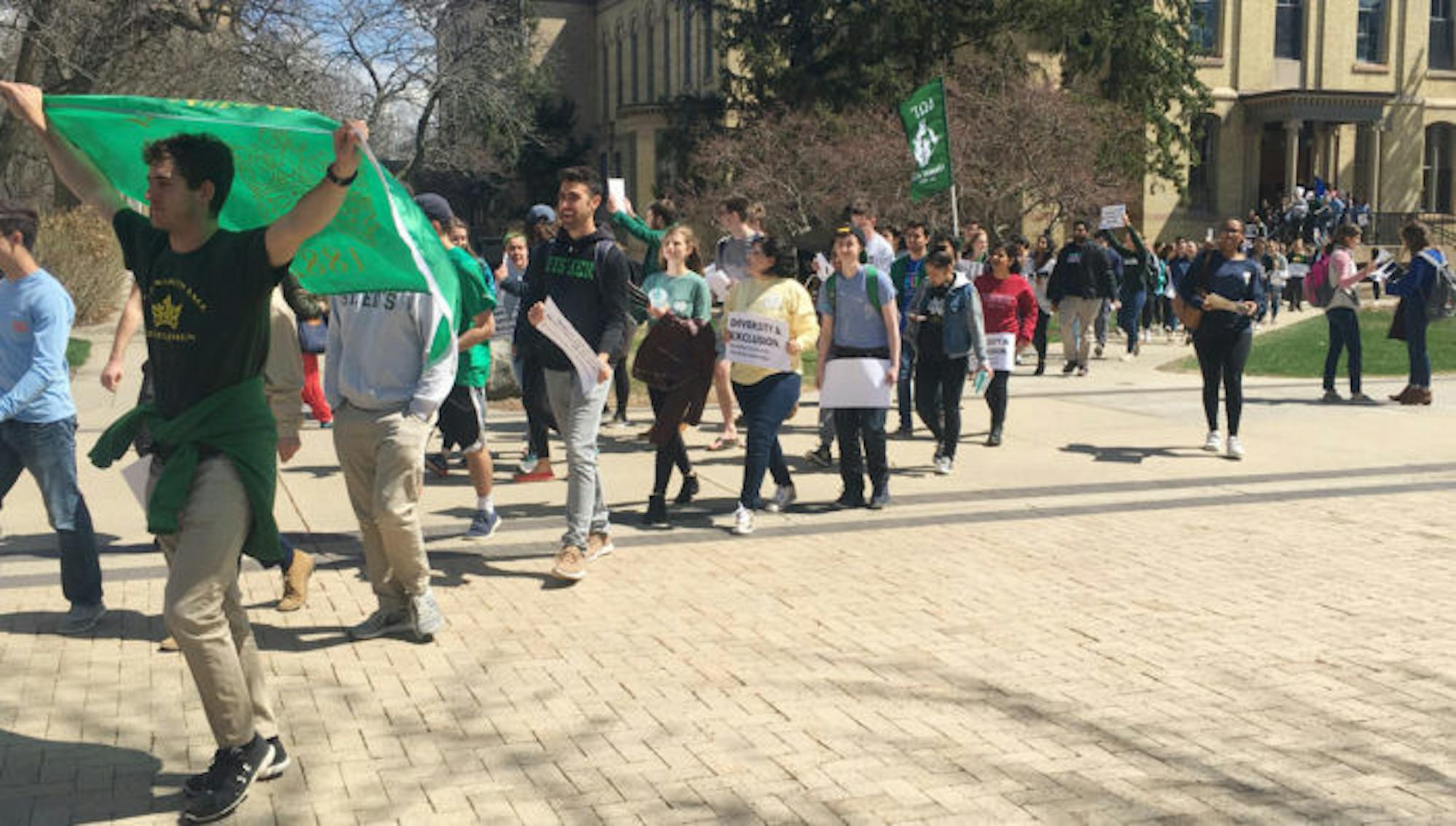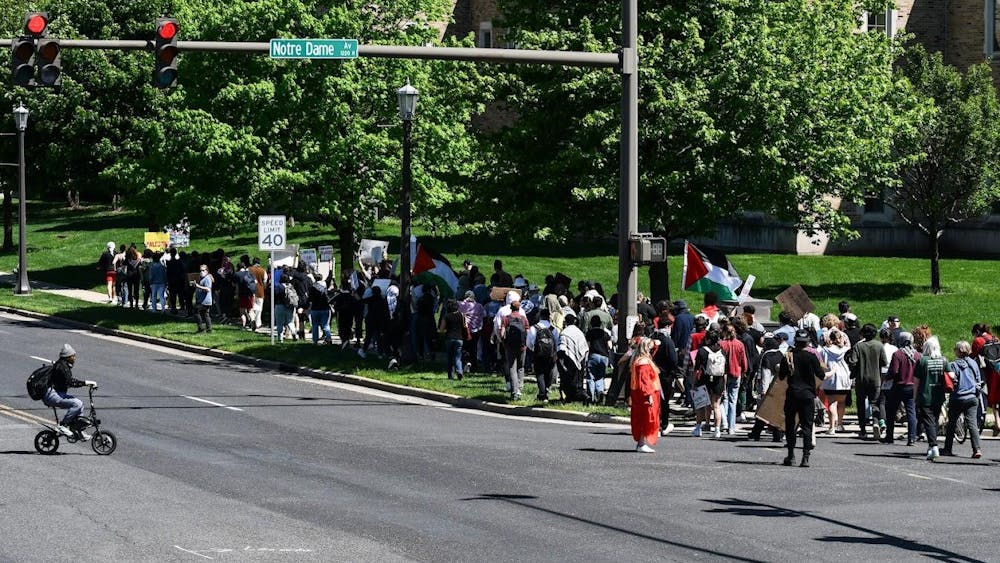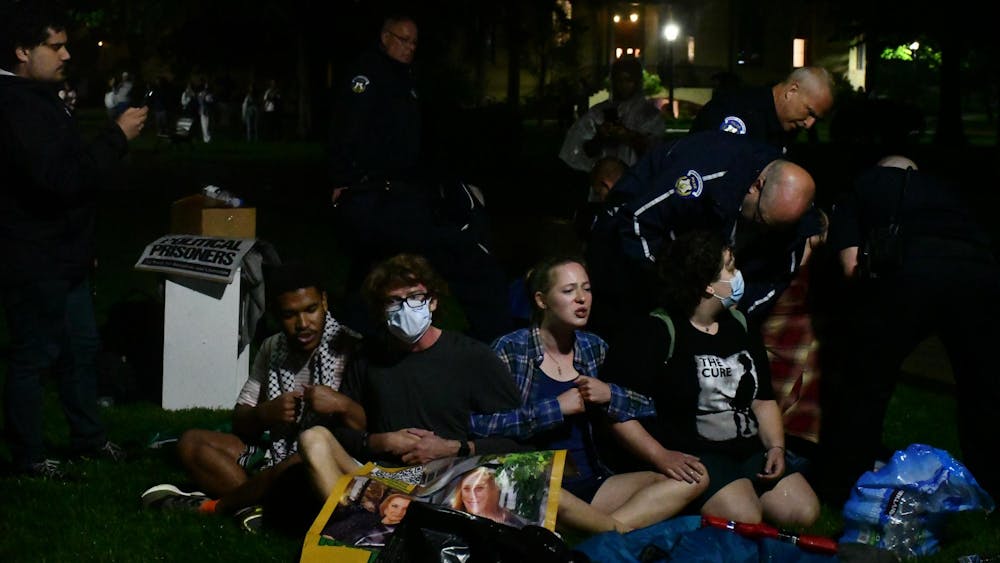In an email sent to the student body early Thursday morning, the Office of Residential Life and the Division of Student Affairs announced changes in residential policies as a means of improving the dorm experience for students now required to stay on campus for six semesters and to incentivize seniors to stay on campus for their final year. The policies were met with an outcry from students and alumni who argued that the policies designed to “differentiate on-campus and off-campus experiences” are inherently exclusionary and discriminatory.
By noon Thursday, a group of students — including members of the outgoing student government executive cabinet — created a Facebook event titled “Sit-In Against the Senior Exclusion Policy” planned for Friday afternoon. Close to 2,000 people marked themselves as “going” or “interested” in the event.
Protesters gathered in the Sorin Room of LaFortune Student Center to organize and distribute posters Friday afternoon. At 2:30 p.m., hundreds of protesters exited the building and began walking towards the Main Building. In front of the Main Building, students waved flags representing their dorm communities and chanted phrases including, “We want Erin,” in reference to the vice president of student affairs Erin Hoffmann Harding, and, “Erin lives off-campus.”
Junior Joey Oswald said he attended the protest out of curiosity as well as frustration with the administration’s new policies.
“Part of me just wanted to see the protest, to see what would happen, and part of it was I definitely think the administration made an explicit attempt to exclude off-campus seniors,” Oswald said. “I think they have to attempt to include off-campus seniors, so they should reverse the decision to exclude seniors from dances and interhall sports teams and stuff like that. One thing that I think that they might have missed is that they’re focusing on seniors being leaders in the community, and I think that off-campus seniors can still be a very valuable part of a dorm community. I know that in my dorm in Morrissey, there are seniors that come from off-campus every Sunday to Mass or are at a lot of dorm events, and I always enjoy talking to them.”
While various students appeared in front of the crowd to speak through a megaphone, groups of students began questioning whether they should go inside the building. The event’s organizers had announced through the Facebook event that an agreement had been made with the University administration and Notre Dame Police Department that no protesters would enter the building. However, small groups began to try and enter the building through doors beneath the main steps of the building. These groups were turned away by Notre Dame employees.
At 2:50 p.m., a group of protesters rushed up the steps and entered the Main Building while the event’s organizers tried to dissuade them. When inside the building, a group of approximately 25 students sat down in front of the Office of Student Affairs, located on the second floor.
Freshman Brian Donahoe said the new policies conflict with the principles of community emphasized to students by the University before they first arrive on campus.
“Me and my roommate have hosted three [prospective students] in the last three weeks, and every single time, we really promote how inclusive Notre Dame is and how much community there is, and we say that once you accept the letter of admission, once you’re in, you’re a part of the Notre Dame family for the rest of your life,” Donahoe said. “It feels like they’re already kicking Notre Dame seniors out of the family before they’ve even graduated, going against pretty much all of their propaganda that they have for everyone looking to come to Notre Dame.”
At 3 p.m., protesters began entering the Main Building in larger numbers and eventually over 100 students had gathered outside the Office of Student Affairs’ doors. The doors were locked, but administrators were visible inside watching the students and making phone calls. Protesters began slipping papers and protest signs beneath the doors of the office and chanting that the office places “money first, students last.”
Junior Connor Polk, one of the first protesters to enter the building, said he did so in order to bring greater attention to the demonstration.
“Everybody’s saying, ‘Let us in, let us in,’ and there was no one really stopping us from going in, and in the original protest online it said we were going in the Main Building,” Polk said. “It seemed like no one was coming out, and we were just talking to ourselves. We thought we’d go in and actually see if we can get some people to notice.”
Though he will have graduated by the time the new policies go into effect, Polk said he felt obligated to defend the rights of off-campus students.
“It won’t affect me because I’m graduating in 2020, but I know how important it is to have the seniors included and the off-campus juniors included — I disagree with the three year rule as well — so I think it’s kind of ridiculous that they tack this on to an otherwise-good, informative email,” Polk said. “ ... I hope they repeal the rule. I hope they tell everybody, ‘We understand, we listen, we see the petition, we see your protests and we understand this was wrong.’ The logic behind it does not make sense to me — I can’t fathom how anyone in the administration thought it’d be a good idea to exclude our students from community building activities.”
Junior Savanna Morgan said the new residential policies are particularly damaging to members of marginalized communities.
“Students of color and queer people are disproportionately affected by dorm communities and the toxic environments that they’re forced to stay in, and by penalizing them for moving off-campus, [the administration is] aligning [itself] with a white supremacist agenda … a white supremacist and heteronormative agenda,” Morgan said.
As the clock moved toward 3:30 p.m., the time at which organizers had agreed with the administration that the demonstration would end, protesters began sifting out of the Main Building. At 3:20 p.m., organizers of the protest — including former student body president Gates McGavick, former vice president Corey Gayheart and former chief of staff Briana Tucker — entered the building for the first time during the protest to encourage students to leave before 3:30 p.m.
Even as the demonstration came to an end, Gayheart told the protesters they should continue fighting the University’s policies.
“For you underclassmen that are here, don’t let this go — that’s what [the administration is] expecting us to do,” Gayheart said. “They are expecting us to forget about this this summer, and it will just be rolled out in three years, and nobody will know and we’ll all go on with our lives. Don’t let it go, and keep working and keep using your voice.”
Tucker said that though the majority of protesters stayed outside, she understood what compelled others to enter the building.
“We came in here toward the end, but we all saw students sitting down peacefully, not obstructing any doorways, so even though they didn’t necessarily follow the rules, they did come in here, and they were respectful,” Tucker said. “It can be frustrating when we’re literally on the exterior trying to speak to someone inside, and so I think for some people, taking that step and being a little more active in their protest was important.”
Though an agreement had been made not to enter the building, McGavick said if the administration doesn’t want students protesting in the building, they should avoid giving them cause to do so.
“It illustrates how offended people have been by this policy,” McGavick said. “I understand that administrators might be upset people came in the building, but they have to realize that just indicates just how hurtful this policy is. At the end of the day, it’s on them to make policies that don’t hurt students ... and that’s what happened.”
Outside the building, toward the end of the demonstration, protesters wrapped their arms over each other’s shoulders and sung the Alma Mater. No University representative addressed the crowd throughout the course of the day.













